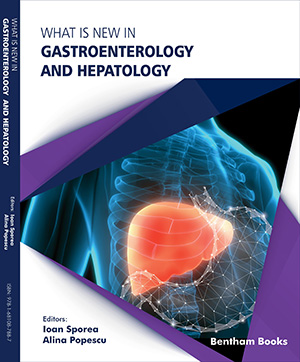Abstract
Hepatic encephalopathy is a neurological condition that affects people who have an insufficient liver function. However, its pathophysiology is yet unclear. For hepatic encephalopathy, pharmacotherapy is the primary treatment choice. Lowering ammonia levels, enhancing neurotransmitter signal transduction, and modifying gut microbiota, tackles the pathophysiology of hepatic encephalopathy. The intestinal microbiota of liver disease patients differs greatly from that of healthy people, and this difference is linked to the development of hepatic encephalopathy. Additionally, gut microbiota is intimately linked to several theories in the pathophysiology of hepatic encephalopathy, such as the GABA-ergic tone hypothesis, bile acid circulation, ammonia poisoning theory, and neuroinflammation, all of which exacerbate patients' cognitive and motor impairments. Providing some probiotics or reestablishing the intestinal bacteria's balance has a substantial impact on neurological illnesses in hepatic encephalopathy. The goal of this review is to determine the possible metabolic impacts and microbiological pathways in the gut-brain axis mediated progression of hepatic encephalopathy, as well as its potential function as a therapeutic target.
[http://dx.doi.org/10.1155/2012/642108] [PMID: 23316223]
[http://dx.doi.org/10.1007/s12072-017-9812-3] [PMID: 28770516]
[http://dx.doi.org/10.3389/fcimb.2020.595759] [PMID: 33553004]
[PMID: 21857820]
[http://dx.doi.org/10.1016/j.cld.2020.01.002] [PMID: 32245525]
[http://dx.doi.org/10.1097/MOG.0000000000000527] [PMID: 30893082]
[http://dx.doi.org/10.1016/j.jceh.2014.06.004] [PMID: 26041962]
[http://dx.doi.org/10.1093/gastro/gox013] [PMID: 28533911]
[PMID: 25830558]
[http://dx.doi.org/10.4081/cp.2017.987] [PMID: 29071061]
[http://dx.doi.org/10.3389/fcell.2022.880544] [PMID: 35493075]
[http://dx.doi.org/10.3389/fcell.2021.748253] [PMID: 34900994]
[http://dx.doi.org/10.1007/978-1-4939-0897-4_3] [PMID: 24997029]
[http://dx.doi.org/10.4103/bc.bc_32_18] [PMID: 30693343]
[http://dx.doi.org/10.3389/fnins.2023.1242254] [PMID: 37790586]
[http://dx.doi.org/10.1002/jcp.25518] [PMID: 27512962]
[http://dx.doi.org/10.3389/fendo.2022.817100] [PMID: 35250873]
[http://dx.doi.org/10.3390/microorganisms10091866] [PMID: 36144468]
[http://dx.doi.org/10.3390/microorganisms7010014] [PMID: 30634578]
[http://dx.doi.org/10.1038/srep08096] [PMID: 25644696]
[http://dx.doi.org/10.1016/j.jcmgh.2015.04.003] [PMID: 26090511]
[http://dx.doi.org/10.12938/bmfh.18-032] [PMID: 31384519]
[http://dx.doi.org/10.1016/j.ijbiomac.2023.123853] [PMID: 36863676]
[http://dx.doi.org/10.3389/fmicb.2023.1117644] [PMID: 36819064]
[http://dx.doi.org/10.3389/fnut.2023.1110536] [PMID: 36875849]
[http://dx.doi.org/10.1016/j.freeradbiomed.2022.12.087] [PMID: 36586452]
[http://dx.doi.org/10.1016/j.biopha.2023.114300] [PMID: 36696803]
[http://dx.doi.org/10.3389/fnut.2022.1062323] [PMID: 36618677]
[http://dx.doi.org/10.3389/fnut.2022.1071284] [PMID: 36698477]
[http://dx.doi.org/10.3748/wjg.v7.i2.152] [PMID: 11819754]
[http://dx.doi.org/10.1007/s11011-013-9388-0] [PMID: 23463489]
[http://dx.doi.org/10.3390/biomedicines11051272] [PMID: 37238943]
[http://dx.doi.org/10.2147/IDR.S254403] [PMID: 33061482]
[http://dx.doi.org/10.1111/cei.13158] [PMID: 29920643]
[http://dx.doi.org/10.3389/fimmu.2021.658354] [PMID: 34122415]
[http://dx.doi.org/10.1186/s12974-022-02510-1] [PMID: 35706008]
[http://dx.doi.org/10.1155/2013/271359] [PMID: 23935246]
[http://dx.doi.org/10.1016/j.jceh.2018.06.008] [PMID: 30302045]
[http://dx.doi.org/10.1016/j.jceh.2012.08.004] [PMID: 25755435]
[http://dx.doi.org/10.1152/ajpgi.00152.2012] [PMID: 22821944]
[http://dx.doi.org/10.1007/s11940-020-00636-2] [PMID: 32834714]
[http://dx.doi.org/10.3389/fendo.2020.00025] [PMID: 32082260]
[http://dx.doi.org/10.1113/JP276431] [PMID: 30066368]
[http://dx.doi.org/10.1186/s12883-021-02544-7] [PMID: 34996385]
[http://dx.doi.org/10.1038/s41531-023-00554-5] [PMID: 37460569]
[http://dx.doi.org/10.1002/mds.29063] [PMID: 35607987]
[http://dx.doi.org/10.1007/s11011-016-9938-3] [PMID: 28012068]
[http://dx.doi.org/10.3390/nu10050564] [PMID: 29734664]
[http://dx.doi.org/10.3390/ijms21239234] [PMID: 33287416]
[http://dx.doi.org/10.3390/ijms23168999] [PMID: 36012266]
[http://dx.doi.org/10.3390/ijms23031105] [PMID: 35163038]
[http://dx.doi.org/10.1016/j.cld.2011.12.009] [PMID: 22321468]
[http://dx.doi.org/10.1042/BSR20222524] [PMID: 37279097]
[http://dx.doi.org/10.3748/wjg.14.3438] [PMID: 18528945]
[http://dx.doi.org/10.1111/j.1478-3231.2007.01562.x] [PMID: 17919230]
[PMID: 6797170]
[http://dx.doi.org/10.4254/wjh.v11.i6.489] [PMID: 31293718]
[http://dx.doi.org/10.1111/j.1365-2036.2010.04574.x] [PMID: 21251030]
[PMID: 36864944]
[http://dx.doi.org/10.1155/2020/1463108] [PMID: 32714397]
[http://dx.doi.org/10.4140/TCP.n.2020.171] [PMID: 32192566]
[http://dx.doi.org/10.1016/j.hbpd.2018.01.005] [PMID: 29428113]
[http://dx.doi.org/10.1007/s11011-016-9826-x] [PMID: 27121846]
[http://dx.doi.org/10.1111/hepr.12429] [PMID: 25266207]
[PMID: 25422653]
[http://dx.doi.org/10.1177/1756283X15607414] [PMID: 26929784]
[http://dx.doi.org/10.4161/gmic.28684] [PMID: 24690956]
[http://dx.doi.org/10.1136/bmj.38048.506134.EE] [PMID: 15054035]
[http://dx.doi.org/10.1155/2013/236963] [PMID: 23653636]
[http://dx.doi.org/10.3390/jcm10184050] [PMID: 34575157]
[http://dx.doi.org/10.1186/s12967-023-04262-9] [PMID: 37330571]
[http://dx.doi.org/10.1152/physrev.00018.2018] [PMID: 31460832]










